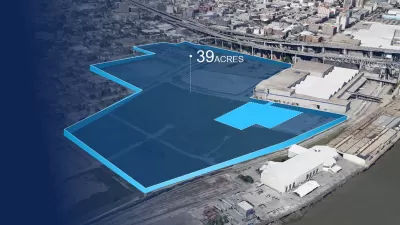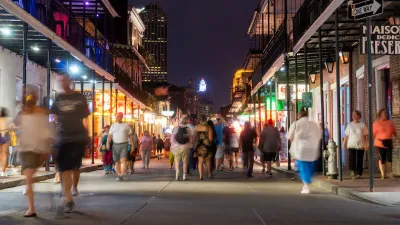The project, led by Gensler, will span 39 acres of residential units, retail, and cultural attractions.

New Orleans "is slated to join the nationwide trend towards megadevelopments with the 39-acre River District, a new 2.4 million square-feet mixed-use district upriver from New Orleans’s Crescent City Connection Bridge," writes Matthew Marani in The Architect's Newspaper. The project's design will be led by Gensler and a group of partners known as the River District Neighborhood LLC. "In its proposal, the River District Neighborhood noted that the project will include over 1,000 market-rate residential units, 450 workforce and affordable housing units, a 750,000 square-foot corporate campus, as well as a number of cultural attractions, retail and dining, hotels, public parks, art installations, and the Louisiana Civil Rights Museum."
The first phase of construction, which is scheduled to start this year and last until 2023, " will focus on road and sidewalk construction and other infrastructure improvements, as well as the museum, nearly 100,000 square feet of retail, and two hotels." The proposal, Marani says, "does attempt to connect to the city at large through several planning features, namely the potential $40 million extension of the Riverwalk streetcar line into the area, a number of protected bike lanes, as well as pedestrian-friendly street layouts." Addressing criticism about displacement, the developers claim that "approximately 30 percent of retail space will be reserved for disadvantaged business enterprise, also known as DBEs, and that the River District Neighborhood LLC counts 27 percent African American equity ownership as well as 18 percent women equity ownership."
FULL STORY: Gensler to lead design of the $1 billion New Orleans River District

Alabama: Trump Terminates Settlements for Black Communities Harmed By Raw Sewage
Trump deemed the landmark civil rights agreement “illegal DEI and environmental justice policy.”

Planetizen Federal Action Tracker
A weekly monitor of how Trump’s orders and actions are impacting planners and planning in America.

Why Should We Subsidize Public Transportation?
Many public transit agencies face financial stress due to rising costs, declining fare revenue, and declining subsidies. Transit advocates must provide a strong business case for increasing public transit funding.

Understanding Road Diets
An explainer from Momentum highlights the advantages of reducing vehicle lanes in favor of more bike, transit, and pedestrian infrastructure.

New California Law Regulates Warehouse Pollution
A new law tightens building and emissions regulations for large distribution warehouses to mitigate air pollution and traffic in surrounding communities.

Phoenix Announces Opening Date for Light Rail Extension
The South Central extension will connect South Phoenix to downtown and other major hubs starting on June 7.
Urban Design for Planners 1: Software Tools
This six-course series explores essential urban design concepts using open source software and equips planners with the tools they need to participate fully in the urban design process.
Planning for Universal Design
Learn the tools for implementing Universal Design in planning regulations.
Caltrans
Smith Gee Studio
Institute for Housing and Urban Development Studies (IHS)
City of Grandview
Harvard GSD Executive Education
Toledo-Lucas County Plan Commissions
Salt Lake City
NYU Wagner Graduate School of Public Service



























